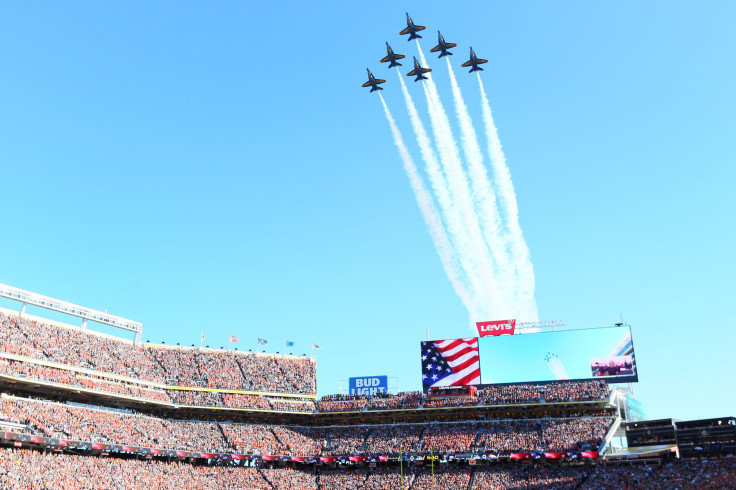How Do They Time Stadium Flyovers? Super Bowl 2017 Will Feature Thunderbirds Flying Over NRG Stadium

On football's biggest stage, fractions of a second can make the difference between victory or defeat. Quarterbacks and receivers spend countless hours timing and coordinating routes so that the pass is thrown at the precise speed and at the exact spot for a catch to be made.
But that's simple stuff when you compare it to the spectacle that occurs before a Super Bowl.
This Sunday, millions of dollars worth of military equipment will be flying at hundreds of miles per hour, in perfect formation, over a packed stadium at the exact moment a singer belts out the final note of the national anthem.
Military jets flying over the Super Bowl has become as much a part of pre-game festivities as the singing of the "Star Spangled Banner." The maneuver is called a "flyover" and it's been a part of the Super Bowl since nearly the beginning. Before Super Bowl II in 1968, Air Force jets flew over Miami's Orange Bowl. Footage survives of a flyover of F-4 Phantoms at Super Bowl VI in 1972, and the timing isn't quite as precise as it would later become, as the video shows the sound of the jets drowning out the end of the anthem.
On Sunday, the Air Force's Thunderbirds will conduct a flyover of NRG Stadium in Houston as country singer Luke Brian finishes the national anthem.
The Thunderbirds will use a variety of tools to hit their exact mark, not the least of which is their own training and skill: the Thunderbirds are the Air Force's public demonstration team, so only some of the Air Force's very best pilots make the cut.
But skill alone won't put the Thunderbirds screaming overhead at the precise instant that Bryan belts out the word "brave."
The pre-game festivities are scripted down to the second, making it much easier for the Thunderbirds to calculate their timing based on distance and wind speed. They also have a holding area, which is a designated place where the pilots can wait, by hovering or circling with their F-16s, for the exact moment they need to fly toward the stadium. A controller at the stadium can coordinate with the pilots while adjusting the moment of departure from the holding area if the pregame festivities veer from the script. Pilots can adjust speed if necessary.
Finally, the singer can help out. While everything is carefully scripted, a singer can hold those final notes a little longer to give the pilots time to get to the stadium. Although if that were to happen, it could cost bettors.
There's a popular prop bet on exactly how long Bryan's rendition of the national anthem will last. Odds makers have put the over/under at 2 minutes and 7.5 seconds.
Bryan, meanwhile, already knows the length of his rendition. After all, he's got to hit his mark.
"There's no telling how long it may go." - Luke Bryan is basically saying take the over on the national anthem
— Will Brinson (@WillBrinson) February 2, 2017
© Copyright IBTimes 2024. All rights reserved.






















